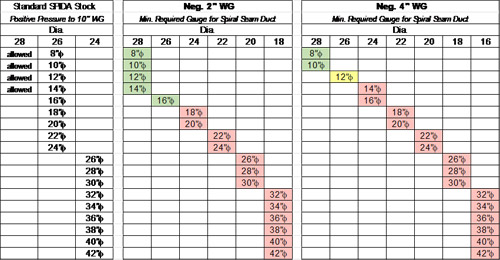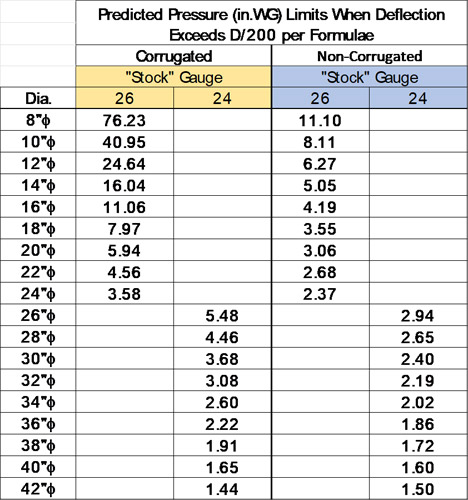Spiral Duct Manufacturers Association (SPIDA) members often fabricate an inventory of standard lengths of round spiral ducts. These are fabricated not only for their own use, but may also be inventory for reps, secondary distributors or contractors. Fabricating “stock” is highly efficient and results in minimal waste. A high percentage of an HVAC duct system could be installed using “stock” rather than cut-to-length or custom duct. This gives not only the advantage of lower cost from duct produced more efficiently, it also greatly reduces lead time by using products that can literally be acquired “same-day.”
A survey of SPIDA members indicates that stock spiral duct is usually made in accordance with gauges for up to 10” WG positive pressure in accordance with the Sheet Metal and Air Conditioning Contractors' National Association (SMACNA) HVAC Duct Construction Standards. The use of 28 gauge material is allowed through 14” diameter per this standard, though most SPIDA members use 26 gauge in those sizes because of material availability, durability of product and some local codes mandating a minimum 26 gauge for commercial construction. This round stock can be used for virtually all commercial HVAC supply, outside and makeup air systems.
But what about negative pressure applications? We’re not talking about fume hoods, dust collectors and industrial exhaust. Those are generally higher negative pressures and their construction is covered by the Industrial Ventilation Manual and the SMACNA Round Industrial Duct Construction Standards. Commercial HVAC systems often have toilet exhaust, ducted return air and general exhaust systems. These systems are seldom designed for negative pressures greater than -2” WG or tested at greater than -4” WG. For those, the SMACNA HVAC Duct Construction Standard has separate tables, Tables 3-10 and 3-11, for minimum gauges. The nature of “stock” is that material is taken for use without control by the manufacturer on where and how it is used. No doubt, plenty of stock positive pressure spiral duct has been used for toilet exhaust systems with no adverse consequences. Yet, if you look at the SMACNA negative pressure tables, there is only a very small range at which you can use this stock spiral duct.

As this table shows, stock spiral duct should only be used in sizes up to 16” diameter at a maximum -2” WG and only to 10” diameter (12” diameter if you have minimum 26 gauge stock) at a maximum -4” WG. SPIDA finds this highly questionable since positive pressure product has undoubtedly been used for negative pressure applications with good results. As a further question, has much of the toilet exhaust, ducted return and general exhaust in commercial HVAC construction been designed and installed as rectangular duct because a heavier (and more expensive) spiral duct has been required?
SPIDA and SMACNA jointly sponsored and funded a study, performed at Tennessee Tech University, titled “Determine the Maximum Negative Operating and Collapse Pressure of Stocked Spiral Duct With and Without Corrugations.” This study focused on the limited range of “stock” spiral duct being produced by SPIDA members with diameters up to 42”. In addition, many SPIDA members produce spiral duct with corrugation, a practice that has been shown to increase strength, rigidity and durability of the product. The goal was to determine up to what size stocked positive pressure duct could also be used for commercial HVAC negative pressure applications.
Much of what we know about spiral duct in negative pressure use comes from collapse tests. Collapse is arguably the ultimate failure, and many in the industry chose minimum gauges based on the predicted collapse of the duct (based on those old collapse tests) with a safety factor of 2 or 3 applied. But that’s not how we are supposed to judge a commercial HVAC duct. The SMACNA HVAC Duct Construction Standard has a Chapter 11 titled “Functional Criteria” which has the “SMACNA Duct Performance Test Standard No. DPTS-2005." Rather than causing a duct to “fail” (collapse) then working backwards, it gives a maximum amount the duct wall can deflect. The method of test is described in this standard, and the allowable measured deflection of the duct wall of a round duct under negative pressure is D/200 (diameter divided by 200). These numbers are quite small. The allowable measured deflection for a 20” diameter spiral duct, for example, would be only 0.10." We have no published studies evaluating wall deflections under negative pressure of spiral ducts based on this test standard, so the results indicate we have been too conservative on the use of round spiral ducts, and expanding that use could produce better and less costly systems.
Samples of corrugated and non-corrugated spiral duct were tested in accordance with the SMACNA DPTS-2005. Measurements were taken at negative pressure increments of 0.5” WG up to 3.0” WG, then at 1.0” increments until one of the three occurred:
- A pressure of -20” WG was obtained.
- Duct wall deflection exceeded 1.00” at any location.
- The duct collapsed.
After the resulting data was plotted, a formula was derived to predict the pressure at which a spiral seam duct was most likely to first exceed the D/200 deflection limit. Those formulae are:
Corrugated Spiral Seam Duct
Plimit (in.WG) = 1.552 x 109 (t/D)2.785
Non-Corrugated Spiral Seam Duct
Plimit (in.WG) = 5.432 x 104 (t/D)1.406
Based upon this data, the allowable negative pressures for which “stock” spiral duct could be used are as follows:
 *** based on “minimal” thicknesses of 0.019” for 26 gauge and 0.024” for 24 gauge.
*** based on “minimal” thicknesses of 0.019” for 26 gauge and 0.024” for 24 gauge.Based on these results, the non-corrugated spiral ducts stocked by SPIDA members for positive pressure applications can be used for commercial HVAC applications up to -1.0” WG through 42” diameter, up to -2.0” WG through 34” diameter, and up to -4.0” WG through 16” diameter. Additionally, these tests further confirm what we know about the additional wall strength we get from corrugating spiral duct. In markets where toilet exhaust, general exhaust and ducted return might be required to exceed -2” WG, corrugating this “stock” spiral duct could greatly extend the range for which it could be used. It almost doubles the allowable pressure before exceeding D/200 for ducts up to 28” diameter. Above those sizes, corrugation ceases to have much effect on reducing wall deflection. But the 18” through 28” diameter range is significantly one where round spiral duct could be, but is often not, designed for commercial HVAC negative pressure applications.
What is the bottom line? Based on the results of this study, we have been greatly overstating the material requirements for using spiral duct in commercial HVAC applications of toilet exhaust, general exhaust and ducted return air where pressures do not exceed -2” WG. In addition, much of this duct could have been pulled from stock “same-day” rather than being fabricated non-standard from a SPIDA member. Based on nominal material weights, the following savings could have been realized:
 GREEN denotes 1 even gauge lighter, BLUE denotes 2 even gauges lighter and ORANGE denotes 3 even gauges lighter.
GREEN denotes 1 even gauge lighter, BLUE denotes 2 even gauges lighter and ORANGE denotes 3 even gauges lighter.
When compared with the SMACNA recommendations for rectangular duct at -2” WG, those gauges are generally aligned with comparable sizes of the positive pressure “stock” product from SPIDA members. So, rather than a premium for using spiral gauges much heavier than necessary, you could have been using roughly the same pounds of duct, but with a product that could have been purchased “same-day”, installs in roughly twice the pounds per man-hour of labor, leaks half as much when properly installed and transports air more efficiently. The industry needs to re-examine the use of rectangular duct for most of these commercial HVAC negative pressure applications. They are missing an opportunity to get a better duct system for less money and with shorter lead times.
Dr. Steve Idem and Pat Brooks contributed to this white paper.







